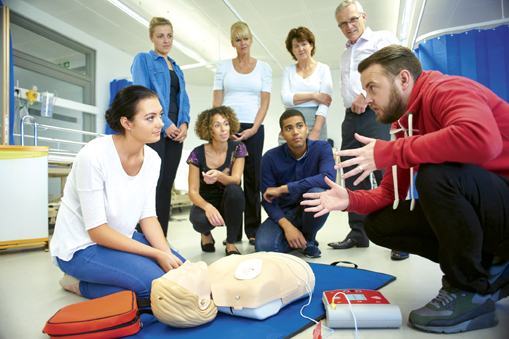Risk Management
Steps your agency can take to prepare for sudden medical emergencies
In February of 2002, a group of co-workers were taking a lunchtime walk when suddenly one of them felt faint and collapsed to the ground. Her co-workers had no idea what was wrong, but could tell she was in trouble and called 911 for help. After placing the call, they waited … and waited … and waited, until finally the county sheriff arrived, followed shortly by the fire department and ambulance.
For every minute the heart isn’t working, the chance of survival goes down 10%.
The story I just related happened to us at Ottawa Kent, located on Main Street in Jenison, Michigan. Linda E. Anderson, my friend and co-worker for 20 years, had suffered a sudden cardiac arrest. While emergency services did get her heart back in rhythm, too much time had passed to prevent brain damage and she passed away two months later, leaving behind her husband and daughter.
Even though we have the best emergency services available, things can still go horribly wrong. For instance:
- There was a police officer at the high school just down the road, but everyone had trouble finding “Old Chicago Drive,” which cost valuable minutes.
- Even though there is a fire department less than a block away, we are all volunteers, which cost valuable minutes.
- Linda’s co-workers didn’t recognize what was wrong and weren’t trained to help her even if they did.
Linda’s death was one of the most devastating experiences I can remember. Not only did I lose a close friend, but we also lost a valued member of our Ottawa Kent team.
While clearing out her office, I took a picture of it. I saw that her calendar had events scheduled that she would never attend. I saw pictures of her nephew, her dog, her co-worker Vicki, and her daughter. There were a few awards and a coffee cup she received from a client. And an empty chair.
After this happened, I learned everything I could about sudden cardiac arrest and what to do to help someone who is stricken with it. I also made a promise to make sure that companies we work with know the importance of having the necessary tools available should such an event occur.
What is sudden cardiac arrest (SCA) and how is it different from a heart attack?
A heart attack occurs if blood flow to part of the heart muscle is blocked, but the heart usually doesn’t stop beating. SCA is when the heart loses its rhythm and thus its ability to pump blood. It can happen in people who appear healthy and have no known heart disease or other risk factors. That was the case with Linda. Most people die from it and it is one of the leading causes of death in the United States.
 What could have changed what happened to Linda?
What could have changed what happened to Linda?
An Automated External Defibrillator (AED), Cardiopulmonary Resuscitation (CPR) and the training to deliver them.
Why is this important?
For every minute the heart isn’t working, the chance of survival goes down 10%. How long does it take to get an AED to a patient? Ask yourselves these questions:
- Do you have an AED, and if so, where is it located?
- Is it maintained, and by whom?
- Are your people trained to use it and perform CPR?
I was recently asked to speak in front of a group in a building I was very familiar with. I asked the audience these same questions:
- Is there an AED in this building, and where is it?
- Is it maintained?
- Who is trained to use it and give CPR?
Only a single person in a group of 30 thought there was an AED in the building but had no idea where it was. They were shocked when I told them we all walked past it as we entered the room.
As I left the meeting I stopped and looked at the AED, saw that the battery was dead and informed the facility immediately. A few weeks later they had to use this AED when one of their employees had a sudden cardiac arrest.
The five links in the adult “Chain of Survival”
A chain is only as good as its weakest link. Survival from cardiac arrest depends on a sequence of interventions:
- Immediate recognition of sudden cardiac arrest and activation of the emergency response system
- Early CPR with an emphasis on chest compressions (it buys time and slows deterioration of the brain and heart)
- Rapid defibrillation (restores heart rhythm)
- Effective advanced life support (stabilizes the patient)
- Integrated post-cardiac arrest care
Doctors say if any of the first three links of the chain are missing, the last two links don’t matter. Just having an AED isn’t enough.
I was doing a risk management review with a controller in the office of a manufacturing plant and asked if they had an AED. He said no but that it sounded like a great idea. We went for a tour of the factory and guess what I spotted—an AED.
Ottawa Kent has 55 employees in four offices. We have an AED in each office and we all know how to use it, and at least half of us are CPR trained.
A few years ago I started a nonprofit called Employers for Better Health & Safety in collaboration with local employers, our regional hospital, Spectrum Health, Ottawa & Kent County EMS, and other safety and wellness professionals. The mission is to improve the health and safety of our community members by increasing awareness of SCA and reducing risk through the collaborative efforts of Western Michigan employers.
We created an award to recognize employers who go above and beyond in supporting their employees’ health and safety. The award is named in memory of Linda E. Anderson. So far, we have given out 13 awards covering 1,800 employees with more than 30 AEDs.
I want to leave you with a few thoughts on what you can do to be prepared for the risk of cardiac arrest:
- This can happen to anyone at any time, even to someone who appears to be healthy.
- Know the five links in the adult “Chain of Survival” and the important role you play within the chain.
- Get an AED—it is a critical piece of safety equipment.
- Get trained in CPR and on using an AED.
- Know where AEDs are located and observe their maintenance.
While we don’t know if having an AED and being trained on how to use it could have saved Linda, we do know that without one she never had a chance.
I want to challenge everyone to discuss the risk of sudden cardiac arrest in your workplace, and to determine if you are prepared. If you are, that is great. But if not, don’t wait to get an AED and first-aid training.
Be sure to encourage your clients and anyone who will listen to do the same. Remember the saying: “Discipline weighs ounces; regret weighs tons.”
The author
Randy Boss is a Certified Risk Architect at Ottawa Kent in Jenison, Michigan. As a Risk Architect, he designs, builds and implements risk management and insurance plans for middle market companies in the areas of safety, work comp, human resources, property/casualty & benefits. He has over 40 years experience and has been at Ottawa Kent for 36 years. He is the co-founder of OSHAlogs.com, an OSHA compliance and injury management platform. Randy can be reached at rboss@ottawakent.com.






